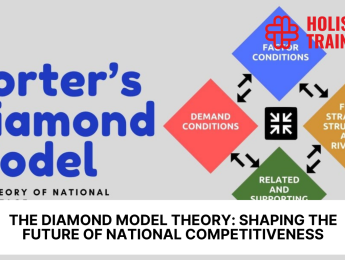- Table of Contents
- What Is the Diamond Model Theory?
- Why Is the Diamond Model Theory Important in Economics?
- What Are the Key Components of the Diamond Model Theory?
- What Are Some Real-World Examples of the Diamond Model in Action?
- How Has the Diamond Model Theory Evolved Over Time?
- What Future Directions Can We Anticipate for the Diamond Model Theory?
Introduction
The Diamond Model Theory, established by Michael Porter in 1990, provides a comprehensive framework for understanding the international competitiveness of industries. It revolves around four key elements—Factor Conditions, Demand Conditions, Related and Supporting Industries, and Firm Strategy, Structure, and Rivalry—and includes the influence of Government and Chance. This article examines the model's components, global applications, and evolution, offering insights into how nations can strategically boost their industrial competitiveness. This makes it an essential tool for policymakers, businesses, and academics alike.
What Is the Diamond Model Theory?
The Diamond Model Theory, developed by economist Michael Porter in 1990, is a framework that explains why certain industries within particular nations are more competitive internationally than others. It focuses on understanding the competitive advantages that nations or regions develop in the global market.
The theory is structured around four main attributes that form a "diamond," suggesting that these factors interact to create a conducive environment for industry success. These key factors are:
- Factor Conditions: This involves the nation’s position in factors of production, such as skilled labour, infrastructure, and technological readiness. It's not just the abundance of these factors, but also the country's capacity to continually innovate and upgrade them.
- Demand Conditions: The nature of home-market demand for the industry’s product or service. The theory posits that a sophisticated and demanding local market leads to firms striving for innovation and quality, enhancing competitiveness.
- Related and Supporting Industries: The presence or absence of supplier industries and related industries that are internationally competitive. Successful industries tend to be clustered geographically and benefit from robust, efficient, and innovative input providers.
- Firm Strategy, Structure, and Rivalry: How companies are created, organised, and managed, as well as the nature of domestic rivalry. High levels of competition between firms within the nation can spur increases in efficiency and innovation.
Additionally, the model incorporates two external variables, Government and Chance, which influence all four attributes of the diamond. Government policies can affect each point of the diamond by encouraging or discouraging investments, innovation, and competition. Chance events such as significant technological breakthroughs or global shifts can disrupt industry conditions and unexpectedly alter competitive positions.
Porter’s Diamond Model provides a systematic approach to analysing and understanding nations' competitive advantages. Academics, policymakers, and businesses widely use it to strategise and benchmark global competitiveness.
Why Is the Diamond Model Theory Important in Economics?
The Diamond Model Theory is significant in economics for several key reasons:
- Understanding Competitive Advantage: It offers a clear framework for understanding how countries develop competitive advantages in particular industries. This is crucial for explaining variations in economic performance and why some nations excel in specific sectors.
- Policy Formulation: The model is highly influential in shaping government economic policies. By identifying the determinants of national advantage, policymakers can design strategies that enhance these elements, such as investing in advanced education systems, infrastructure, and technological innovation.
- Business Strategy Development: Companies use the Diamond Model to identify the competitive conditions of their industries. Understanding the model can help businesses make strategic decisions regarding where to invest, expand, and innovate based on different locations' competitive advantages or disadvantages.
- Promotion of Innovation and Cluster Development: The model emphasises the role of geographical and inter-industry clusters, where proximity to capable suppliers and related industries spurs increased efficiency, innovation, and knowledge sharing. This has guided many regional development policies and initiatives to create competitive industry clusters.
- Globalisation Insights: Porter’s theory helps explain how and why industries across different nations can compete globally, offering insights into the effects of globalisation on various sectors. It allows for an understanding of how economies can position themselves in a rapidly globalising world.
- Academic Research and Debate: The Diamond Model has stimulated extensive academic research and debate, encouraging further exploration into the complexities of competitive advantage. It has been a foundational model in international business and trade research, leading to refinements and extensions of the original theory.
- Adaptability and Evolution: The theory’s consideration of dynamic factors like technological advancement and the role of government policy in shaping industries makes it adaptable to changing global economic conditions. This adaptability has kept the Diamond Model relevant as an analytical tool for economic development in a changing world.
Importance Aspect | Description |
Understanding Competitive Advantage | Provides a clear framework for understanding how nations develop competitive advantages in specific industries, crucial for explaining variations in economic performance. |
Policy Formulation | Influences government economic policies by identifying national competitive determinants, guiding strategic investments in education, infrastructure, and innovation. |
Business Strategy Development | Helps companies identify competitive conditions, enabling strategic decisions on investments, expansions, and innovations based on local competitive advantages. |
Promotion of Innovation and Cluster Development | Emphasises the role of geographic and industry clusters, enhancing efficiency and innovation through close proximity to suppliers and related industries. |
Globalisation Insights | Offers insights into global competition and the effects of globalisation, helping understand how economies can strategically position themselves in the global market. |
Academic Research and Debate | Stimulates extensive research and debate, serving as a foundational model in international business and trade research, leading to further refinements and extensions. |
Adaptability and Evolution | Adapts to changing global conditions through its dynamic framework, maintaining relevance as an analytical tool for economic development and policy-making. |
Table 1: The importance of the Diamond Model Theory in economics
The Diamond Model Theory provides a comprehensive structure for analysing nations' competitive strengths and weaknesses, influencing economic theory and practical business and policy decisions globally.
What Are the Key Components of the Diamond Model Theory?
The Diamond Model Theory, developed by Michael Porter, consists of four key components or attributes, often called the "diamond." These components interact with each other and are crucial for understanding national competitive advantage. Here’s a breakdown of each:
- Factor Conditions: These are the inputs used in the production process, which include labour, land, natural resources, capital, and infrastructure. Unlike traditional theories that only consider inherited factors such as natural resources and unskilled labour, Porter’s model emphasises the creation and expansion of more advanced factors, like skilled labour, technological prowess, and innovative capacity. When creating, upgrading, and sustaining these advanced factors, nations gain competitive advantages.
- Demand Conditions: This component focuses on the nature and scale of the home market demand for the industry's products and services. Porter argues that more demanding local customers drive firms to innovate and improve competitiveness. A sophisticated domestic market pushes companies to meet high standards, preparing them to succeed globally.
- Related and Supporting Industries: Competitive input suppliers and supporting industries within a nation can bolster innovation and international competitiveness. The presence of internationally competitive supplier industries and related industries provides cost-effective inputs and quick innovation implementation. Clusters of related industries, such as Silicon Valley’s high-tech companies, exemplify how proximity can enhance performance and spur competitive success.
- Firm Strategy, Structure, and Rivalry: How firms are created, organised, and managed, as well as the nature of domestic competition, form this pillar of the diamond. Intense rivalry in the domestic market propels firms to seek improvements and innovations to gain a competitive edge. Moreover, the national context and culture in which firms compete will shape their strategies and organisational structures.
In addition to these four determinants, Porter introduced two additional variables that influence the national diamond:
- Government: The role of the government can either enhance or detract from a nation’s competitive advantage. Effective government actions can support the development of the diamond’s components through sound economic policies, investments in education and infrastructure, and support for industries.
- Chance: Events outside of control, such as significant technological innovations or global economic shifts, can reshape industry conditions and alter competitive positions. These events can disrupt the status quo and change a nation's relative strengths in the global economic landscape.
These components and external factors collectively explain how countries create and sustain competitive advantages in various industries, highlighting the dynamic nature of national competitive strength.
What Are Some Real-World Examples of the Diamond Model in Action?
The Diamond Model Theory, by analysing how competitive advantages are formed based on national characteristics, offers valuable insights into various industries across different countries. Here are some real-world examples illustrating the Diamond Model in action:
- Japan's Automobile Industry:
- Factor Conditions: Japan has developed highly skilled labour and advanced robotics technology, which are crucial for modern automotive manufacturing.
- Demand Conditions: Japanese consumers have high expectations regarding quality and fuel efficiency, which pushes local manufacturers to innovate continuously.
- Related and Supporting Industries: Japan has a strong network of suppliers that provide high-quality materials and parts, enhancing automobile manufacturers' efficiency and innovation.
- Firm Strategy, Structure, and Rivalry: Intense competition among leading firms like Toyota, Honda, and Nissan drives innovation and efficiency within the industry.
- Switzerland’s Pharmaceutical Industry:
- Factor Conditions: Switzerland boasts a highly educated workforce and a strong focus on research and development, particularly in chemical and pharmaceutical sciences.
- Demand Conditions: The strong local demand for high-quality healthcare products and a well-developed healthcare system encourage pharmaceutical companies to innovate.
- Related and Supporting Industries: Switzerland has a cluster of world-leading chemical and pharmaceutical research facilities and companies that support the pharmaceutical industry.
- Firm Strategy, Structure, and Rivalry: Firms like Novartis and Roche benefit from a competitive environment that stresses innovation, regulatory compliance, and global outreach.
- Germany’s Machinery and Equipment Industry:
- Factor Conditions: Germany has a long tradition of engineering expertise, technical education, and apprenticeship programs that produce highly skilled labour.
- Demand Conditions: German manufacturers benefit from sophisticated local demand and strong export markets requiring high-performance, durable machinery.
- Related and Supporting Industries: The machinery industry is supported by a dense network of suppliers and related companies, including those in the automobile and industrial sectors.
- Firm Strategy, Structure, and Rivalry: Many small and medium-sized enterprises (SMEs) in this sector foster a strong culture of innovation and specialisation.
- United States’ Technology Sector (Silicon Valley):
- Factor Conditions: The U.S. has a strong educational system for technology, particularly in universities such as Stanford and UC Berkeley, which provide talented human resources and cutting-edge research.
- Demand Conditions: There is a large domestic market with a high demand for tech innovations and a culture that encourages experimentation and entrepreneurship.
- Related and Supporting Industries: Silicon Valley benefits from an ecosystem of tech firms, venture capital, and supportive legal and business services specialised in technology.
- Firm Strategy, Structure, and Rivalry: Intense competition among tech giants like Google, Apple, and Facebook drives rapid innovation and growth.
These examples demonstrate how the Diamond Model helps explain the competitive success of industries across different countries. They reflect the unique combinations of factors, demand conditions, related industries, and firm strategies within each national context.
How Has the Diamond Model Theory Evolved Over Time?
Since its introduction by Michael Porter in 1990, the Diamond Model Theory has evolved in response to criticisms and changing global economic conditions. Here are some key ways in which the model has been adapted and expanded:
- Incorporation of Additional Roles: Initially, the Diamond Model focused predominantly on four determinants of national advantage. Over time, Porter acknowledged the significant roles of two additional factors: government and chance. These factors are now often considered part of the extended model, acknowledging that government policies and random events can critically shape the competitive environment.
- Integration with Globalisation: As globalisation intensified, the original model's focus on the national level was seen as somewhat restrictive. Porter and others have extended the model to better account for global supply chains and the operations of multinational corporations. This includes considering how home-country advantages can be leveraged globally and how global strategies can influence and be influenced by the national diamond.
- Application to Subnational Regions and Cities: Researchers and practitioners have applied the principles of the Diamond Model to smaller geographic units like states, regions, and cities. This adaptation considers how local competitiveness clusters contribute to success, focusing on how specific locales can develop competitive advantages in the context of the larger national economy.
- Sector-Specific Adaptations: The model has been tailored to address the specific conditions of various industries. For instance, adaptations have been made to better fit the services sector, technology industries, and knowledge-based industries, where traditional factors like natural resources are less relevant than human capital and innovation.
- Interdisciplinary Approaches: The Diamond Model has evolved to be combined with other theoretical frameworks. For example, insights from institutional theory have been integrated to understand better how formal and informal rules, norms, and behaviours affect competitive advantage.
- Addressing Sustainability and Social Elements: More recent model adaptations incorporate sustainability and corporate social responsibility as components of competitive advantage. This reflects a broader shift in global business priorities towards sustainable practices and the role of businesses in achieving social goals.
- Empirical Testing and Methodological Enhancements: The model has been subjected to extensive empirical testing across different countries and industries. These studies have helped refine the model's components and their interactions, leading to a more nuanced understanding of what drives competitive success.
- Educational and Training Frameworks: The Diamond Model has been widely adopted in business and economic education to train students and professionals to understand competitive dynamics. This educational adoption has also fed back into the model's development, as teaching the model has led to new insights and adaptations.
Evolution Aspect | Description |
Incorporation of Additional Roles | Added the roles of government and chance to the model, recognising their significant impact on the competitive environment. |
Integration with Globalisation | Expanded the model to account for global supply chains and multinational operations, emphasising the interplay between national advantages and global strategies. |
Application to Subnational Regions and Cities | Applied the model's principles to smaller geographic units like states, regions, and cities, focusing on local competitiveness and specific advantages. |
Sector-Specific Adaptations | Tailored the model for various industries, including services, technology, and knowledge sectors, adapting it to sectors where traditional factor conditions are less relevant. |
Interdisciplinary Approaches | Combined the Diamond Model with other theoretical frameworks, such as institutional theory, to enhance understanding of competitive advantage influences. |
Addressing Sustainability and Social Elements | Incorporated sustainability and corporate social responsibility into the model, aligning it with modern business priorities and roles in achieving social goals. |
Empirical Testing and Methodological Enhancements | Conducted extensive empirical testing to refine the model's components and their interactions, enhancing its accuracy and applicability. |
Educational and Training Frameworks | Adopted widely in business and economic education, leading to new insights and adaptations through its teaching and application in academic and professional training settings. |
Table 2: The evolution of the Diamond Model Theory
Through these evolutions, the Diamond Model remains a vital tool in analysing competitive advantage, reflecting its ability to adapt to the complexities and changes in the global economic landscape.
What Future Directions Can We Anticipate for the Diamond Model Theory?
As the global economic landscape evolves, the Diamond Model Theory will likely adapt and expand in several key directions to maintain its relevance and utility. Here are some anticipated future directions for the Diamond Model:
- Greater Emphasis on Globalisation and Global Networks: As businesses become increasingly globalised, future adaptations of the Diamond Model will likely place more emphasis on international supply chains, global markets, and the operations of multinational corporations. This could involve analysing how companies leverage global assets to enhance their competitive advantage in their home country's diamond.
- Incorporation of Digital Transformation: The rise of digital technologies affects every aspect of the Diamond Model. Future iterations may focus more on digital infrastructure, cybersecurity, e-commerce, and the workforce's digital skills as key components of factor conditions. Additionally, an important area of study will be how digital demand conditions shape industries.
- Sustainability and Environmental Factors: Global business strategies increasingly focus on sustainability and environmental impacts. Future developments in the Diamond Model could include ecological conditions and sustainability practices as central components, examining how these influence competitive advantage and compliance with international environmental standards.
- Integration with Entrepreneurial and Innovation Ecosystems: The model might be expanded to include more explicitly elements of entrepreneurship and innovation ecosystems. This includes startup culture, innovation hubs, and the role of venture capital, which are critical for fostering new industries and transforming existing ones.
- Enhanced Role of Government and Policies: Governments play a crucial role in shaping competitive advantages through policies on education, technology, and business. Future versions of the Diamond Model may more deeply integrate the role of government, not just as a supportive element but as a core driver of the national competitive landscape.
- Social and Cultural Dimensions: The model could be enhanced by more explicit social and cultural factors considerations. This would analyse how cultural attitudes towards business, work, innovation, and external trade influence national competitiveness.
- Methodological Improvements: With advancements in data analytics and computational models, the Diamond Model could see methodological improvements. These would allow for more robust testing and refinement of the model, helping to capture the complex interactions of its components better.
- Broader Applicability to Various Economic Sectors: As the global economy diversifies into services, technology, and knowledge-based industries, the model might be adapted to better fit these sectors, which do not rely as heavily on traditional factor conditions.
- Interdisciplinary Approaches: The model could benefit from integrating insights from fields like behavioural economics, political science, and sociology. This multidisciplinary approach can provide a more holistic view of what drives national competitiveness.
By evolving in these directions, the Diamond Model can remain a valuable tool for analysing economic competitiveness in a world characterised by rapid change, technological disruption, and increasing environmental and social challenges.
conclusion
In conclusion, Michael Porter's Diamond Model Theory offers a comprehensive framework for understanding the competitive advantage of nations. By examining how various factors—such as local demand conditions, firm strategy, and the presence of supportive industries—interact within a country, the model explains why certain nations excel in specific industries. While the theory has faced criticism and evolved over time, its core principles remain influential in guiding economic strategies and business decisions. As the global economy transforms, adapting and expanding the Diamond Model will be crucial for capturing the nuances of modern international competition and sustainability. This ongoing relevance underscores the model's foundational role in economic analysis and strategic planning.
























